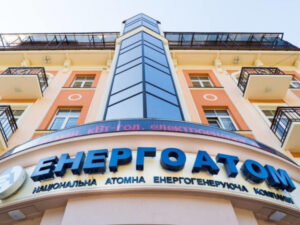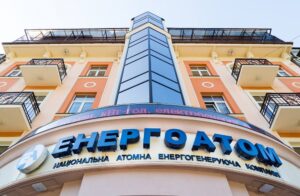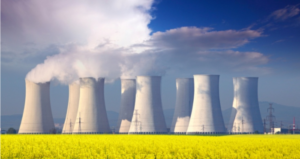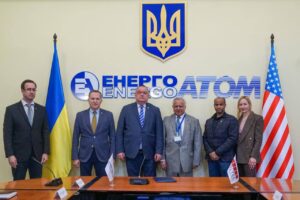
JSC “NAEK ”Energoatom” will be profitable in all three scenarios during 2025-2028, with profits in 2028 expected to be twice as high as in 2026-2027, due in particular to the expected rise in electricity prices.
This forecast is contained in the annual information on fiscal risks prepared by the Ministry of Finance of Ukraine based on data from 12 state-owned companies as part of the adoption of the 2026 state budget. Within the document, basic, alternative, and negative scenarios are modeled for each company based on macroeconomic scenarios for the development of Ukraine’s economy.
“Net revenues from NAEK Energoatom to the state budget are expected in all scenarios and will grow as the company’s profitability increases,” the document says.
As noted by its authors, NAEK plans to build new power units in the long term and has plans in the medium term to attract sufficient debt financing to fund investments. However, construction will continue after the end of the medium-term period, and if such construction is financed through debt obligations, high costs are expected to increase the company’s obligations to a level that it may not be able to service.
“Fiscal risks may materialize if the government has to provide funding to cover part of these costs, or if the government has to service Energoatom’s debts,” the Ministry of Finance concluded.
Under the baseline scenario, Energoatom’s capital expenditures will average about UAH 59 billion per year from 2025 without budget financing, while expenditures on PSO for tariff compensation for the population will decrease by an average of 2.3% in the period 2026-2028.
In addition, the baseline scenario assumes an average increase in electricity prices of 7.9% per year, as well as a slight decrease in the company’s electricity production in 2026-2027, followed by an increase in 2028.
As the Ministry of Finance noted, NAEK received a net profit of UAH 1.3 billion in 2024, compared to a loss of UAH 11.3 billion in 2023. Last year, the company demonstrated a 35% increase in revenue due to a 33.5% increase in the weighted average price of electricity.
According to the results of 2024, the volume of PSO in Energoatom amounted to UAH 109.3 billion, or 53% of the company’s net income for that year.

The Cabinet of Ministers has amended the charter of NAEK Energoatom, in particular by increasing the number of members of its supervisory board from five to seven, four of whom must be independent. The relevant amendments were approved by Cabinet Resolution No. 983 of August 15, 2025, published on the Government Portal.
According to paragraph 74 of the amended charter of Energoatom, the supervisory board consists of seven members, the majority of whom, namely four, must be independent, and three members must represent the state.
According to the company’s report in the NSSMC’s information disclosure system, the amendments supplement the powers of the general meeting of shareholders, and some of their powers have been transferred to the supervisory board.
Thus, the competence of the general meeting of shareholders no longer includes, among other things, the decision to appoint and dismiss the chairman and members of the management board in accordance with the proposals of the supervisory board. According to paragraph 12 of the amended charter, the election and termination of the powers of the chairman and members of the management board is the exclusive competence of the supervisory board. As well as approving the regulations on the management board, reviewing the management board’s report and making decisions based on its results, approving the company’s financial plan, as well as its medium-term (three to five years) investment plan and strategic development plan.
However, the powers of the general meeting of shareholders were expanded to include, in particular, the submission for approval by the Ministry of Finance of proposals on certain financial indicators, the amount of payments to the state, budget financing and quasi-fiscal operations, approving the owner’s letter of expectations based on the State Property Policy and after consultation with the company’s supervisory board, and approving the results of the supervisory board’s performance assessment.
As reported, the Cabinet of Ministers plans to complete the formation of supervisory boards of state-owned energy companies by December 2025, in full compliance with the principle of a majority of independent members, and wants to appoint the heads of such companies on a competitive basis. This is stated in the draft Government Action Program published on August 18.
In its updated Extended Fund Facility (EFF) program for Ukraine following the eighth review in early July, the International Monetary Fund (IMF) noted the need to further strengthen corporate governance of state-owned enterprises in Ukraine, in particular, the immediate appointment of the head of LLC Gas Transmission System Operator and the completion of the formation of the supervisory board of NAEK Energoatom, which provides for the expansion of its composition to seven members.
The supervisory board of Energoatom currently includes its chairman, Jarek Niewierowicz, and deputy chairman, Michael Elliott Kirst, as well as state representatives Timofey Milovanov and Vitaliy Petruk. The third independent member of the supervisory board, Timothy Stone, refused to sign the contract.

Since the beginning of 2025, JSC “NAEK ”Energoatom” has continued to fully perform its special obligations to ensure the availability of electricity for household consumers (PSO), aimed at reducing its cost for the population.
“Since the beginning of the year, Energoatom has already paid UAH 94.3 billion (including VAT) for PSO services. In particular, 100% of the cost of services for January-July 2025 and 60% of the estimated cost for August were covered,” the company said on Tuesday.
According to Energoatom’s financial plan, the estimated cost of PSO services in 2025 is UAH 163.9 billion (including VAT).
“Energoatom is conscientiously fulfilling its obligations to the state by paying for PSO services on time and in full. In addition, we are not stopping and are entering the final stage of the repair campaign, which will enable us to operate at full capacity with all nine power units in the autumn-winter period,” said Energoatom CEO Petro Kotin.
The company recalled that in 2024, NAEK paid UAH 153.2 billion (including VAT) for PSO services.
As reported, in 2024, Energoatom allocated 58% of its net income to PSO payments, with the company’s net profit for the past year amounting to UAH 1.3 billion.
Energoatom currently operates nine power units at the South Ukraine, Rivne, and Khmelnytskyi nuclear power plants with a total capacity of 7,880 MW, located in territory controlled by Ukraine.
The Zaporizhzhia NPP, with six VVER-1000 power units with a total capacity of 6,000 MW, has not been producing electricity since September 11, 2022, following its occupation on March 3-4, 2022.

Yurmash (Kyiv), a company with foreign investment whose main specialization is the supply of foreign construction and road equipment, may supply five Euromash intercity buses (three of which are upgraded) to NAEK Energoatom for UAH 22.91 million, with an expected value of UAH 24.37 million.
According to a report in Prozorro, the company was the only participant in the tender for the purchase of buses, although the customer specified AR-TEMSA PRESTIJ SX buses (or equivalent) as the subject of the purchase.
Auto-Region, the exclusive distributor of Turkish Temsa buses in Ukraine, did not participate in the tender.
According to the documents provided, the Euromash B AC 6768 bus with improved equipment is 7.5 m long, designed for 29+1 seats with seat belts and a seat reclining system, equipped with a 2.97 L Euro 6 diesel engine.
In particular, the bus has an autonomous heater, air conditioning with individual deflectors for each row of seats on both sides.
Additional options, unlike the standard configuration, include USB sockets in the backrests of the front row seats, a microphone, an LSD TV, and a rear view camera.
A letter signed by the company’s CEO states that “the company will use only its own production facilities to manufacture the product,” while the localization certificate states that “the degree of localization is equal to or exceeds the degree of localization for the corresponding year” (in 2025, the law requires 25% localization), but the specific degree is not specified.
The company’s website and open sources do not provide information on the components used in Euromash buses.
Previously, the company offered Euromash (Dongfeng) pickups in tenders. The company is the official dealer of the Chinese Dongfeng in Ukraine.
The company’s website states that it was established in 2004 and is one of Ukraine’s leaders in the import, warranty, and post-warranty service of imported road construction and quarry equipment.
The company is the exclusive dealer of Hitachi construction equipment and an official dealer of BELL, Terex Finlay, Ammann, Furukawa, and Sullair.
According to opendatabot, the ultimate beneficiary of LLC with II “Yurmash” is entrepreneur Anna Pokotilova.
The company’s net income in 2024 increased 1.9 times compared to 2023, to UAH 507.6 million, with a net profit of UAH 3.6 million compared to UAH 0.9 million a year earlier. Before the war in 2021, the company’s revenue amounted to UAH 1.2 billion, and the number of employees was 457, compared to 162 the previous year.

On July 25, at the office of the State Nuclear Regulatory Inspectorate of Ukraine (SNRIU), DIARU), the official transfer of permits to JSC NAEK Energoatom for the performance of organizational and administrative functions related to ensuring the nuclear and radiation safety of Ukrainian nuclear power plants, as well as the Centralized Spent Fuel Storage Facility (CSFSF), took place.
“This stage is part of the company’s reorganization – changing its form of governance from a state-owned enterprise to a joint-stock company,” the company said on Friday.
The licenses were handed over to Energoatom’s head, Petro Kotin, by the head of the State Nuclear Regulatory Inspectorate, Chief State Inspector for Nuclear and Radiation Safety, Oleg Korykov.
He noted that the SNRIU team had conducted inspections of all nuclear facilities and nuclear power plant sites and had given a positive assessment of Energoatom’s ability to comply with safety requirements, standards, and regulations, as well as the terms of the licenses.
“Obtaining licenses to operate under the new status confirms that Energoatom retains its full powers and ensures the continuous operation of nuclear power units,” emphasized the head of Energoatom.
The changes to the licenses were made in line with the law “On the Joint Stock Company National Nuclear Energy Generating Company Energoatom” and the Cabinet of Ministers’ resolution No. 1420 of December 29, 2023. “On the establishment of the joint-stock company ”National Nuclear Energy Generating Company “Energoatom.”
Currently, Energoatom operates nine power units at the South Ukraine, Rivne, and Khmelnytskyi NPPs with a total capacity of 7,880 MW. All of them are located in territory controlled by Ukraine.
The Zaporizhzhia Nuclear Power Plant, with six VVER-1000 power units with a total capacity of 6,000 MW, has not been producing electricity since September 11, 2022, following its occupation on March 3-4, 2022.

NAEK Energoatom and Holtec International signed an agreement on the margins of URC-2025 in Rome, which provides for the construction of a plant for the production of small modular reactors (SMR) and spent nuclear fuel (SNF) containers using Holtec technology, Energoatom head Petr Kotin said.
“The agreement with Holtec is also a forward-looking agreement. It fixes what we plan to do with them. This is a plant to produce SMRs in Ukraine using their technology. They also transfer to us the technology of production of SNF containers,” Kotin said in comments to Interfax-Ukraine after signing the document.
He recalled that Holtec technology was used to build the Centralized Spent Nuclear Fuel Storage Facility (CSNFSF), which constantly needs new containers for it.
“Containers are needed all the time for spent fuel. They are now produced in the United States, and later we will produce them in Ukraine. It will be cheaper,“ – explained the head of ”Energoatom”.
As reported, Energoatom and Westinghouse on the margins of URC-2025 in Rome finalized agreements on the production in Ukraine of nuclear fuel using the technology of the American company.
“We signed a memorandum that consolidates everything that has already been done with Westinghouse (…). And this was just the summarizing part of the documents,” Kotin said in comments to Interfax-Ukraine after signing the memorandum.
Ukraine has not bought nuclear fuel from Russia since 2020 and has also refused to buy spare parts for nuclear reactors.
In June 2022, Energoatom and Westinghouse signed an agreement to supply nuclear fuel for all Ukrainian nuclear power plants.
The CCNF is an autonomous nuclear facility designed for long-term storage of spent nuclear fuel from the Pivdenno-Ukrainian, Khmelnytsky and Rivne NPPs, which until 2021 was exported to Russia for storage and reprocessing, costing Ukraine about $200 million annually. Fuel from these NPPs was supposed to be received by the Central Nuclear Fuel Storage Facility from April 2022, but the war corrected these plans, and the fuel was stored at the plants themselves until 2023, when its pilot operation began.